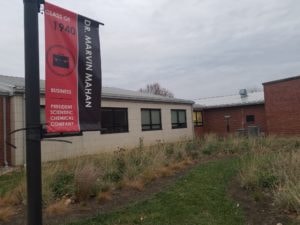At Blackburn College, the Sustainability Club is doing more than talk about leaving a smaller footprint. It’s taking steps to ensure that Blackburn is greener, changing the college for the better to keep the campus more sustainable.
One change is that Leave It To Beaver left the supervision of the work program and is now in the hands of Sustainability Club, lead by senior biology major Ben Fletcher. Leave It To Beaver is located in Olin 127, where students, faculty, and staff can donate gently used, unwanted items for reuse or take something they need (such as a three-ringed binder) for free.
In the past, Leave It To Beaver was not well utilized by the Blackburn community due to its restricted hours. However, Sustainability Club is taking steps to change that. Fletcher explained that after a brief meeting to get a sense of what updates Leave It To Beaver needed, the club cleaned up and separated the unusable items from what could be used. What was still usable was largely donated to Catholic Charities in town so that the club could start fresh. Of changes that are coming, secretary of Sustainability Club and a senior biology major Laurel Petri seemed most enthusiastic about creating a rack for “interview-ready” clothes so students, especially low-income students, can present their best selves for professional opportunities like job interviews.
The club is also looking to expand various existing programs, such as the battery recycling program. In the past, the club put out simple boxes around campus for used batteries, which it then recycled. Their last recycling endeavor yielded about 10 lbs for a total of $0.40, and they expect that they’ll get more as the program continues. The club has since replaced the battery recycling boxes with larger, plastic receptacles painted like batteries, making it easier to identify where to place used batteries for recycling. Another program the club wants to continue is the bike rental initiative. Club leaders are also looking for more information regarding how recycling is handled on campus so that they can quiet rumors that the recycling is not disposed of properly.

The native plants garden on campus is a part of campus’s sustainability program
Other new projects the group is starting include planting a pumpkin patch on campus and putting up a greenhouse to grow fresh lettuce. Programs like this both serve as educational opportunities but also as ways to lower campus costs. Fletcher said, “Every year CAB buys pumpkins, but if they’re here they can save that money. And if once or twice a month Sodexo can use freshly grown lettuce on campus, that’s more money they can save, too.”
The Fletcher and Petri explained that the campus-wide sustainability initiative was a separate but related entity, attempting to bring together such groups as the Physical Plant, Sustainability Club and Pollinator Progress. “Everyone has their cliques,” said Fletcher. “If we can combine them into one sustainability effort, it’ll be strength in numbers.”
Both Fletcher and Petri emphasized a desire to leave something better for the future club members and students after they have graduated; programs like the pumpkin patch won’t impact their lives but can improve the lives of incoming students. They also wanted to see the administration at large become more active in sustainability efforts. Fletcher wanted to see students take an active role in sustainability. “People should be aware of their impact… There are many ways to be green as a student and as a campus, and people should take advantage of it.”

